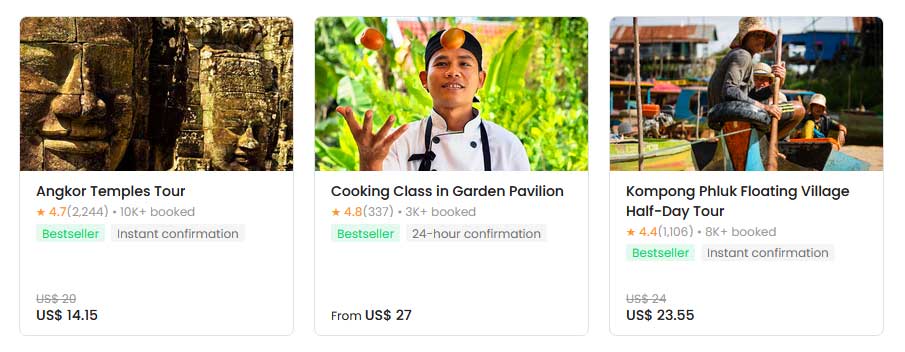
Quick answer: Cambodia is a captivating country known for its rich history, stunning ancient temples, and vibrant culture. It offers incredible experiences from exploring the vast Angkor Wat complex to cruising the unique Tonlé Sap lake. With its traditional dances, abundant wildlife, and warm hospitality, Cambodia blends heritage and nature beautifully, making it a must-visit destination for travelers seeking both adventure and culture.
At a glance:
- 🕌 Angkor Wat: The largest religious monument in the world.
- 🌊 Tonlé Sap: Southeast Asia’s biggest freshwater lake, and its river even reverses direction twice a year.
- 🌀 Royal Dance: The Royal Ballet of Cambodia features elegant, ancient Khmer dance./li>
- 🏞️ Wildlife & Forests: Remote Cardamom Mountains are home to wild elephants and ancient burial caves.
- 🍛 National Dish: Fish Amok – a creamy curry steamed in banana leaves.
- 🚚 Tuk‑tuks: One of the most common and affordable forms of transport in Cambodian cities.
- 🏛️ Elephant Past: The Angkor empire was built using elephants in its ancient constructions.
- 🚧 Emerging Monarchy: Cambodia’s king is elected by a small Royal Council — not inherited directly.
Last updated in November 2025.
Discovering the Charm of Cambodia: 15 Interesting Things.
-
- In the enchanting tapestry of Southeast Asia, Cambodia emerges as an enigmatic gem, where history, culture, and resilience converge in a dance of narratives. Beyond the grandeur of its temples and the echoes of a tumultuous past, Cambodia reveals a tapestry woven with fascinating threads of lesser-known wonders. As we embark on a cultural odyssey through this captivating nation, we peel back the layers to uncover 15 intriguing facets that define Cambodia’s essence.
- Resilience in the Face of Adversity: Cambodia’s recent history, marred by the brutal Khmer Rouge regime, serves as the crucible from which the nation emerged, scarred but resilient. The stories of survival and the indomitable spirit of the Cambodian people add depth to the canvas of this nation, creating a mosaic of strength and hope.
- Culinary Symphony – Flavors of Khmer Cuisine: One cannot truly understand Cambodia without savoring the symphony of flavors that is Khmer cuisine. From the aromatic spices of Amok, a traditional fish curry, to the soul-warming embrace of num banh chok, a rice noodle soup, each dish tells a story of heritage and a deep connection to the land.
- Bamboo Trains and Ingenious Ingenuity: Venturing off the beaten path, Cambodia unveils its inventive spirit with the bamboo trains of Battambang. An ingenious repurposing of railway tracks, these „norry“ offer a unique and exhilarating mode of transport, reflecting the resourcefulness embedded in Cambodia’s cultural DNA.
Threads of Wonder: Delving into Cambodia’s Tapestry.
-
- Land of Smiles – A Nation’s Positive Spirit: Beyond the tragedies of history, Cambodia has earned the endearing moniker of the „Land of Smiles.“ The warmth and welcoming nature of its people, coupled with an irrepressible optimism, create an atmosphere that resonates long after one’s journey through this extraordinary nation.
- Cultural Kaleidoscope – Apsara Dance and Bokator: Delving into Cambodia’s cultural kaleidoscope, we encounter the mesmerizing Apsara dance, a traditional form of expression that weaves tales through graceful movements and intricate costumes. The ancient martial art of Bokator adds a dynamic dimension, showcasing the artistic prowess and physical prowess of the Khmer people.
- Conclusion: As we navigate through these 15 intriguing facets of Cambodia, we find a nation that transcends the boundaries of time and space. It’s a land where the scars of history coexist with the vibrant hues of a resilient culture. Cambodia invites exploration not just of its landscapes but of the stories etched in the hearts of its people. Each facet, whether culinary, historical, or artistic, contributes to the mosaic that is Cambodia—a nation that beckons with open arms, ready to share its captivating tales with those willing to listen.
BOOK a TOUR / ACTIVITY in Cambodia ➜
15 Interesting Things and Facts of Cambodia:
1. Angkor Wat – Jewel of Khmer Architecture:
-
- In the heart of Cambodia lies a masterpiece etched in stone, a testament to the grandeur of the Khmer Empire – Angkor Wat. Nestled amid the lush jungles near Siem Reap, this architectural marvel stands as the largest religious monument globally, an awe-inspiring beacon of ancient ingenuity and spiritual devotion.
- Constructed in the 12th century by King Suryavarman II, Angkor Wat was originally dedicated to the Hindu god Vishnu but later transformed into a Buddhist temple. Its intricate design, colossal towers, and expansive courtyards reflect the architectural prowess and artistic finesse of the Khmer people.
- Approaching Angkor Wat, one is greeted by a magnificent causeway leading to the main entrance, adorned with intricately carved bas-reliefs depicting scenes from Hindu epics like the Ramayana and Mahabharata. The central tower, representing Mount Meru, the cosmic center in Hindu mythology, pierces the sky, commanding attention and reverence.
- As the sun casts its warm glow during sunrise and sunset, Angkor Wat transforms into a surreal canvas, with hues of pink, orange, and gold bathing the temple in an ethereal glow. Tourists and pilgrims alike gather at these moments to witness the magical play of light on the sandstone façade, creating a spiritual ambiance that transcends time.
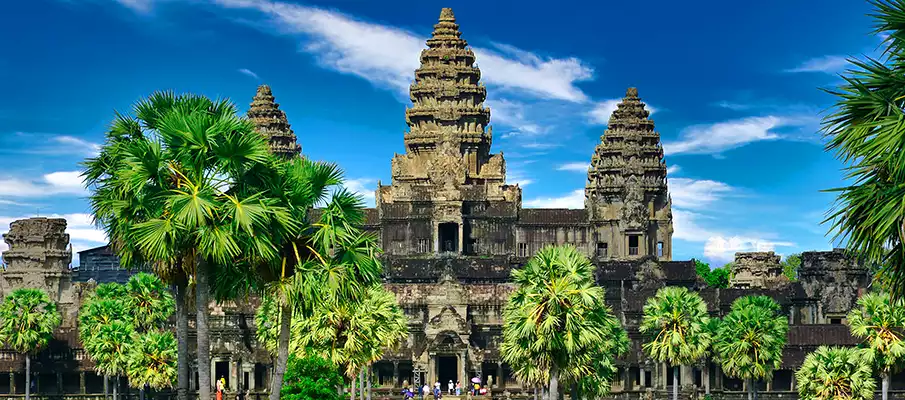
2. Khmer Rouge and the Killing Fields:
-
- In the annals of Cambodia’s history, a somber chapter stands out — the era of the Khmer Rouge and the haunting legacy of the Killing Fields. The late 1970s marked a period of immense suffering, as Pol Pot’s radical regime sought to reshape Cambodia through a brutal and ideologically-driven campaign.
- Led by Pol Pot, the Khmer Rouge aimed to establish an agrarian communist society, forcibly evacuating urban areas and subjecting the population to forced labor in rural collectives. The consequences were catastrophic, with an estimated two million people, a quarter of Cambodia’s population, perishing due to execution, forced labor, or starvation.
- The infamous Tuol Sleng Genocide Museum in Phnom Penh, once a high school converted into a torture and interrogation center, offers a haunting glimpse into the atrocities committed by the Khmer Rouge. The chilling photographs of prisoners, the rusting instruments of torture, and the harrowing accounts of survivors bear witness to the unimaginable cruelty inflicted upon the Cambodian people.
- Yet, perhaps the most poignant reminder of this dark period lies in the Killing Fields, scattered throughout the country. Choeung Ek, one of the most notorious Killing Fields located just outside Phnom Penh, serves as a memorial to the victims. Mass graves, now marked by stupa-like structures, tell a heart-wrenching tale of the lives lost to a senseless ideology.
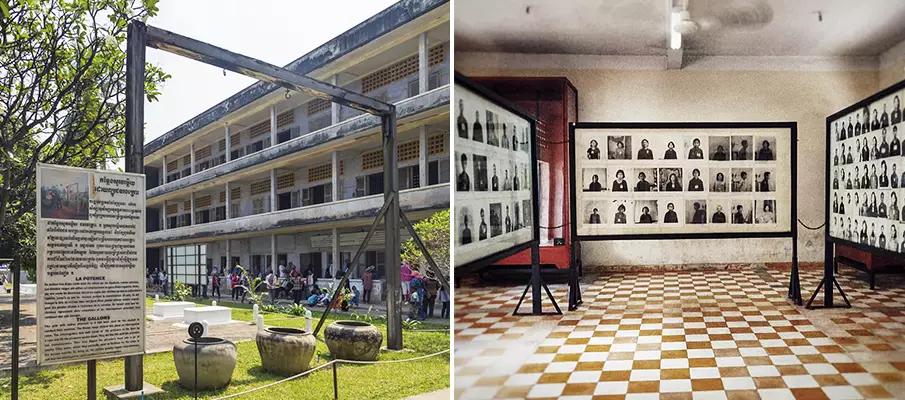
3. Tonle Sap – Southeast Asia’s Largest Lake:
-
- Nestled in the heart of Cambodia, Tonle Sap reigns as Southeast Asia’s largest lake, a dynamic and ever-changing aquatic wonder that shapes both the landscape and the lives of the people who call its shores home.
- What sets Tonle Sap apart is its unique hydraulic system that transforms the lake into a pulsating entity. During the monsoon season, the Mekong River swells, causing Tonle Sap to swell dramatically, increasing its size almost fourfold. This annual phenomenon is a natural marvel, turning the lake into a vital reservoir that sustains diverse ecosystems and nurtures the surrounding fertile lands.
- As the lake expands, its waters flood the surrounding floodplains and forests, creating a lush habitat for a myriad of species. Tonle Sap is not merely a body of water; it’s a thriving ecosystem teeming with fish, birds, and other aquatic life. The lake plays a crucial role in supporting the livelihoods of the communities settled along its shores, providing sustenance and economic opportunities.
- The floating villages that dot Tonle Sap’s surface are a testament to the harmonious relationship between the lake and its inhabitants. Stilted houses, schools, and markets rise above the water, reflecting a way of life intricately intertwined with the lake’s ebbs and flows. Locals navigate the waters in colorful boats, creating a vibrant tableau that mirrors the dynamic pulse of Tonle Sap.
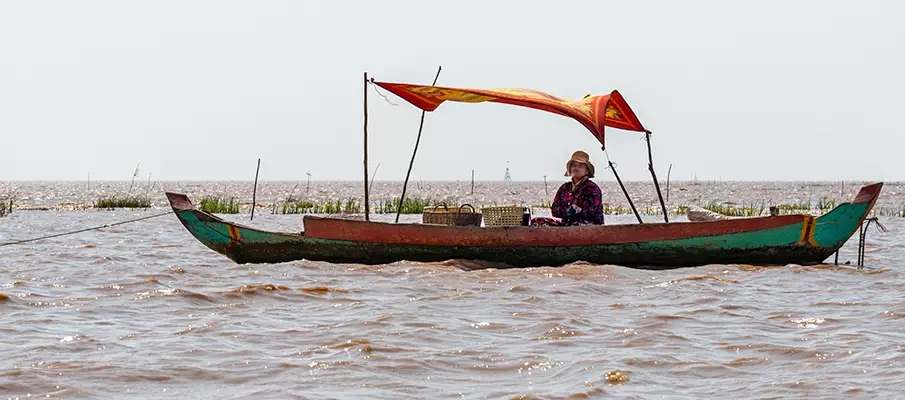
4. Incredible Cuisine – A Symphony of Flavors:
-
- Embark on a culinary journey through Cambodia, where each dish unfolds as a harmonious symphony of flavors, revealing a rich tapestry of culinary traditions deeply rooted in history and culture. Khmer cuisine, characterized by its exquisite balance of flavors and aromatic profiles, is a delightful fusion of fresh herbs, bold spices, and a diverse array of textures. At the heart of Cambodian gastronomy is a commitment to using locally sourced ingredients, ensuring that each dish is a celebration of the country’s bountiful landscapes.
- Amok – A Culinary Masterpiece: One cannot delve into Cambodian cuisine without savoring the iconic Amok. This traditional fish curry is a masterpiece of flavors, where fresh fish is enveloped in a velvety coconut milk and curry paste, then delicately steamed in banana leaves. The result is a dish that encapsulates the essence of Khmer cooking – a perfect balance of sweet, savory, and aromatic notes.
- Num Banh Chok – Rice Noodle Elegance: For those seeking a taste of everyday Cambodian life, Num Banh Chok is a must-try. This simple yet soul-satisfying dish features rice noodles bathed in a fragrant fish-based broth and topped with an array of fresh herbs, vegetables, and sometimes, a hint of coconut milk. It’s a breakfast staple that encapsulates the essence of Cambodian comfort food.
- Kampot Pepper – A Global Sensation: No exploration of Cambodian cuisine is complete without a nod to Kampot pepper. Hailing from the Kampot province, this pepper variety has achieved global acclaim for its unique flavor profile. Renowned for its floral notes and subtle heat, Kampot pepper has become a prized ingredient in kitchens worldwide, elevating dishes with its unparalleled aromatic richness.
- Street Food Delights: Beyond formal dining, Cambodia’s vibrant street food scene offers a sensory adventure. From savory nom krok, coconut rice cakes topped with green onions, to skewers of grilled meats marinated in lemongrass and turmeric, the streets of Cambodia are a playground for food enthusiasts seeking authentic, flavorful experiences.
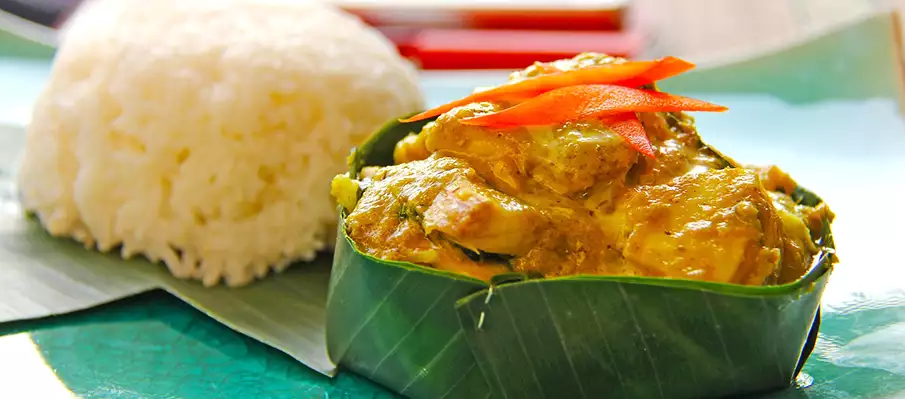
5. Bamboo Trains of Battambang:
-
- In the laid-back province of Battambang, Cambodia, a whimsical form of travel unfolds: the Bamboo Trains, affectionately known as „norry.“ Born from necessity after the Khmer Rouge era disrupted traditional rail travel, these bamboo platforms, powered by motorcycle engines, offer a bumpy yet exhilarating ride through the picturesque countryside.
- Ingenious Adaptation: Crafted from bamboo and mounted on disused railway tracks, the Bamboo Trains are a testament to local ingenuity. What began as a pragmatic solution to transportation challenges has evolved into a unique and authentic experience for both locals and intrepid travelers.
- A Bumpy Adventure: The rhythmic clatter of wheels against tracks sets the tone for a rustic adventure. Riding the Bamboo Train immerses you in Battambang’s rural landscapes—verdant rice fields, palm trees, and traditional stilt houses—all viewed from a quirky, open-air platform.
- Preserving Tradition: As modernization encroaches, efforts are underway to preserve this vanishing tradition. The Bamboo Trains stand not just as a mode of transport but as a cultural relic, providing a nostalgic glimpse into Cambodia’s resilient spirit and the resourcefulness of its people.
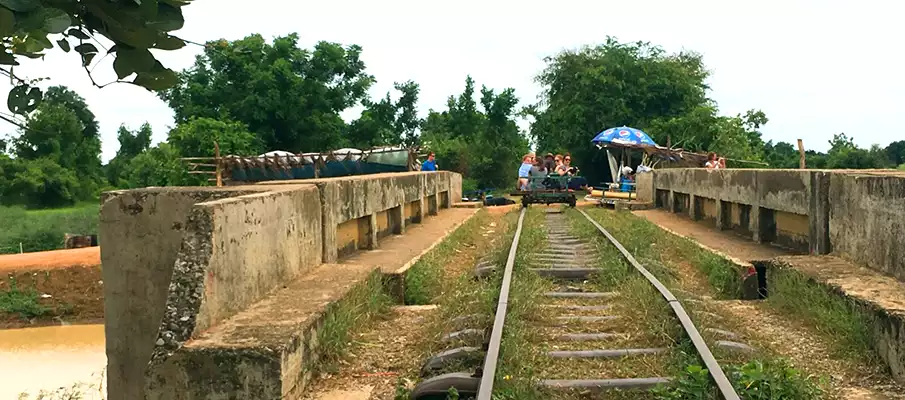
6. Phnom Penh – Pearl of Asia:
-
- Nestled along the banks of the mighty Mekong River, Phnom Penh, the capital city of Cambodia, stands as the vibrant beating heart of the nation. Often hailed as the „Pearl of Asia,“ this city seamlessly weaves together a rich tapestry of history, culture, and modernity.
- Royal Splendor: Phnom Penh is adorned with architectural jewels that reflect its regal past. The Royal Palace, a gilded masterpiece, showcases traditional Khmer design and is home to the sacred Silver Pagoda, where a life-sized golden Buddha captivates visitors. The grandeur of these structures echoes Cambodia’s royal legacy.
- French Colonial Elegance: Evident in its tree-lined boulevards and colonial-era buildings, Phnom Penh bears the influence of French colonial rule. The allure of places like Psar Thmei, the Central Market, lies not just in the goods for sale but in the architectural charm that transports visitors to a bygone era.
- Riverside Serenity: The confluence of the Mekong and Tonle Sap rivers offers a serene escape along the city’s riverfront. Strolling along Sisowath Quay, one can soak in the view of boats lazily gliding on the water, capturing the essence of the city’s unhurried pace.
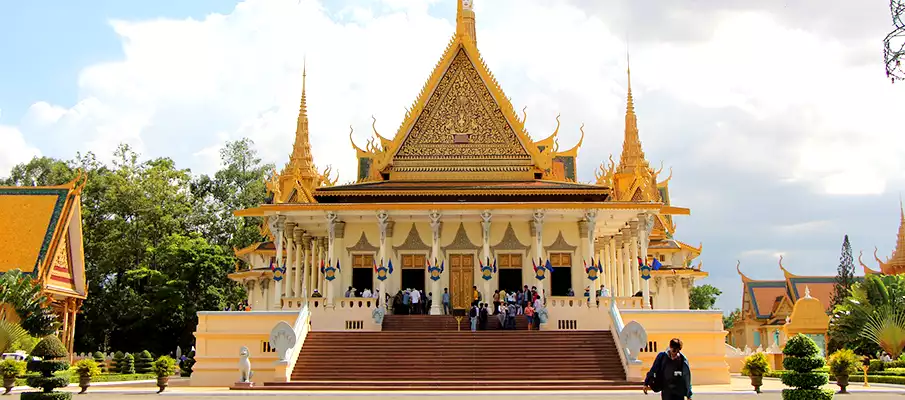
7. Rare Irrawaddy Dolphins of the Mekong:
-
- In the tranquil waters of the Mekong River, a remarkable and rare spectacle unfolds – the presence of the Irrawaddy dolphins. Gracing the stretches of the Mekong that flow through Cambodia, these elusive creatures are more than marine marvels; they are guardians of the country’s waterways, captivating both locals and visitors alike.
- Mysterious Elegance: With their distinctive rounded faces and humpless backs, Irrawaddy dolphins possess an air of mysterious elegance. Their unique appearance sets them apart from other dolphin species, making encounters with these gentle creatures along the Mekong an extraordinary experience.
- The Mekong as Home: The Mekong River, one of the world’s great waterways, provides a vital habitat for the Irrawaddy dolphins. While their numbers have dwindled over the years due to factors such as habitat loss and fishing practices, efforts to protect these rare dolphins have been implemented to ensure their continued presence in the Mekong.
- Guardians of the Waters: Considered sacred by some local communities, the Irrawaddy dolphins are symbolic guardians of the river. Their presence is a testament to the delicate balance of the Mekong ecosystem, where these marine mammals serve as indicators of the river’s health and vitality.
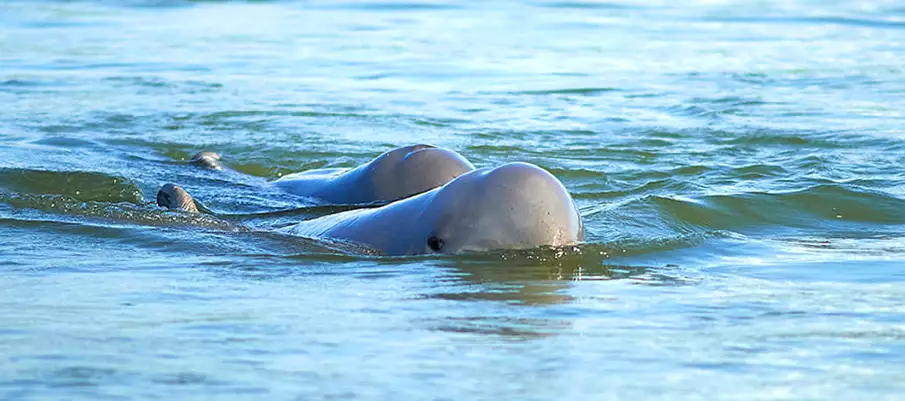
8. Kampot Pepper – A Global Sensation:
-
- Nestled along Cambodia’s southern coast lies the province of Kampot, renowned not only for its scenic landscapes but also for a culinary treasure that has captured the taste buds of connoisseurs worldwide – Kampot Pepper. This exceptional spice, celebrated for its unique flavor profile, has transcended local fame to become a global sensation, gracing the tables of renowned chefs and home cooks alike.
-
- Cultivation in the Kingdom: The cultivation of Kampot Pepper dates back to the 13th century, and today, it holds the coveted status of being one of the first agricultural products in Cambodia to receive Geographical Indication (GI) status. Grown in the fertile red soil of the region, the pepper vines benefit from the unique microclimate, rich soil, and traditional cultivation methods passed down through generations.
-
- Distinctive Flavor Palette: What sets Kampot Pepper apart is its distinctive flavor palette. Renowned for its floral notes, citrus undertones, and a mild heat that lingers on the palate, Kampot Pepper brings a complexity that elevates dishes to new culinary heights. The pepper comes in various forms – black, white, red, and green – each offering a nuanced flavor experience.
-
- Global Acclaim: Kampot Pepper’s journey from local spice to global sensation is a testament to its exceptional quality. Acclaimed chefs around the world seek out this pepper for its unparalleled taste, incorporating it into a myriad of dishes to add depth and sophistication. Its popularity extends beyond haute cuisine, finding a place in kitchens where a dash of excellence is appreciated.
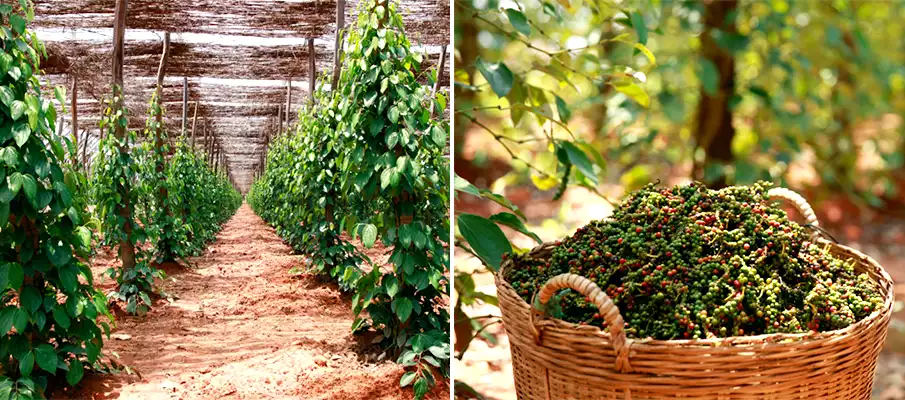
9. Preah Vihear – Majestic Mountain Temple:
-
- Perched atop the Dângrêk Mountains, in the northern reaches of Cambodia, lies the awe-inspiring temple of Preah Vihear. This UNESCO World Heritage site stands as a testament to Khmer architectural prowess and spiritual devotion, commanding panoramic views that stretch into both Cambodia and Thailand.Architectural Splendor: Preah Vihear, dedicated to the Hindu god Shiva, unfolds as a masterful example of Khmer architecture. Carved into the cliffside, the temple complex comprises a series of sanctuaries connected by grand staircases and pavilions. The intricately carved lintels, galleries adorned with bas-reliefs, and towering gopuras showcase the artistic finesse of the Khmer civilization.Spiritual Sanctuary: Dating back to the 9th century, Preah Vihear served as a spiritual sanctuary for Khmer kings who sought divine protection for their realms. The site’s strategic location atop the Dângrêk Mountains not only symbolized a connection between Earth and the heavens but also provided a vantage point for observing celestial events.
Panoramic Views: The journey to Preah Vihear involves ascending a series of staircases that wind up the mountainside, rewarding visitors with breathtaking panoramas. The temple’s elevated position allows for unobstructed views of the lush landscapes and neighboring plains, creating a sense of serenity and awe that enhances the spiritual significance of the site.
- Perched atop the Dângrêk Mountains, in the northern reaches of Cambodia, lies the awe-inspiring temple of Preah Vihear. This UNESCO World Heritage site stands as a testament to Khmer architectural prowess and spiritual devotion, commanding panoramic views that stretch into both Cambodia and Thailand.Architectural Splendor: Preah Vihear, dedicated to the Hindu god Shiva, unfolds as a masterful example of Khmer architecture. Carved into the cliffside, the temple complex comprises a series of sanctuaries connected by grand staircases and pavilions. The intricately carved lintels, galleries adorned with bas-reliefs, and towering gopuras showcase the artistic finesse of the Khmer civilization.Spiritual Sanctuary: Dating back to the 9th century, Preah Vihear served as a spiritual sanctuary for Khmer kings who sought divine protection for their realms. The site’s strategic location atop the Dângrêk Mountains not only symbolized a connection between Earth and the heavens but also provided a vantage point for observing celestial events.
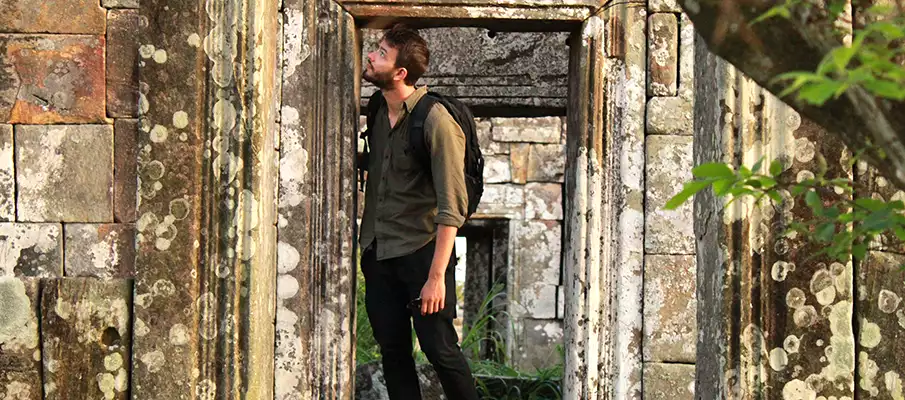
10. Sihanoukville (+Koh Rong) – Tropical Paradise:
-
- Nestled along the Gulf of Thailand, Sihanoukville stands as Cambodia’s premier coastal destination, known for its sun-kissed beaches and vibrant atmosphere. A short boat ride away lies Koh Rong, an island paradise that adds an extra layer of allure to this coastal haven.Sihanoukville’s Beach Bliss: Sihanoukville boasts pristine beaches like Otres and Serendipity, offering sunseekers a haven of white sands and crystal-clear waters. Beyond the shores, a lively beach town unfolds, adorned with beachfront bars, seafood shacks, and a laid-back ambiance that captivates visitors.Koh Rong’s Island Escape: A ferry ride from Sihanoukville transports you to Koh Rong, a tropical haven known for its untouched beauty. With powdery beaches, lush jungles, and azure waters, Koh Rong beckons those seeking an island escape. The island’s rustic charm and diverse marine life make it a paradise for snorkelers and nature enthusiasts.
Beachfront Vibes: In Sihanoukville, beachfront promenades buzz with activity. From vibrant nightlife at Serendipity Beach to the serene retreats along Otres, each stretch offers a unique experience. Whether you’re savoring fresh seafood, trying water sports, or simply basking in the sun, Sihanoukville’s coastal vibes are contagious.
- Nestled along the Gulf of Thailand, Sihanoukville stands as Cambodia’s premier coastal destination, known for its sun-kissed beaches and vibrant atmosphere. A short boat ride away lies Koh Rong, an island paradise that adds an extra layer of allure to this coastal haven.Sihanoukville’s Beach Bliss: Sihanoukville boasts pristine beaches like Otres and Serendipity, offering sunseekers a haven of white sands and crystal-clear waters. Beyond the shores, a lively beach town unfolds, adorned with beachfront bars, seafood shacks, and a laid-back ambiance that captivates visitors.Koh Rong’s Island Escape: A ferry ride from Sihanoukville transports you to Koh Rong, a tropical haven known for its untouched beauty. With powdery beaches, lush jungles, and azure waters, Koh Rong beckons those seeking an island escape. The island’s rustic charm and diverse marine life make it a paradise for snorkelers and nature enthusiasts.

11. Banteay Srei – The Citadel of Women:
-
- Nestled amidst the Angkor Archaeological Park in Cambodia, Banteay Srei stands as a petite yet exquisite jewel in the temple crown, earning the poetic moniker „The Citadel of Women.“ This intricately carved temple, dedicated to the Hindu god Shiva, unfolds as a testament to Khmer artistry and devotion.
-
- Architectural Splendor: Built in the 10th century, Banteay Srei is renowned for the finesse of its pink sandstone carvings. Despite its smaller size compared to other Angkorian temples, the level of detail in the bas-reliefs and intricate sculptures is unparalleled. Every surface tells a story of mythological tales, celestial dancers, and divine deities.
-
- The Name’s Significance: The epithet „Citadel of Women“ is derived from the belief that the delicate carvings could only have been crafted by the hands of women. The level of precision and the intricacy of the artwork led to this poetic association, emphasizing the temple’s unique charm and the supposed involvement of feminine grace in its creation.
-
- Khmer Artistry Unveiled: Banteay Srei showcases the pinnacle of classical Khmer art. The intricate carvings exhibit a level of craftsmanship that reflects not only religious fervor but also a deep appreciation for aesthetics. Visitors marvel at the well-preserved depictions of Hindu mythology, including scenes from the Ramayana and Mahabharata.
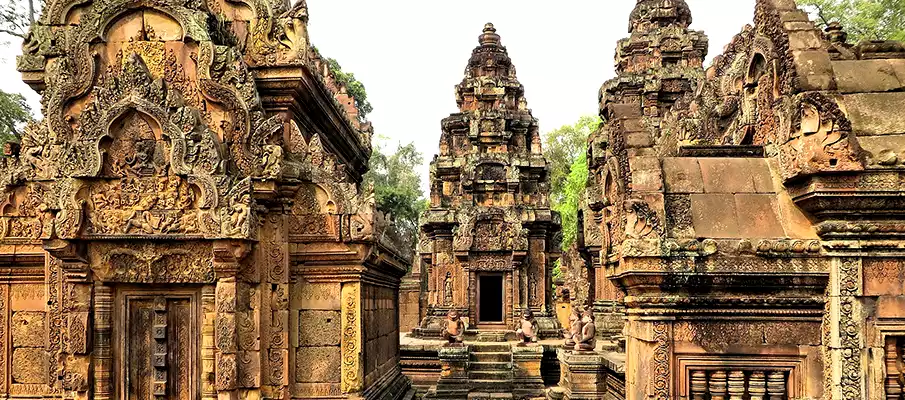
12. Traditional Apsara Dance:
-
- In the heart of Cambodian culture, the Traditional Apsara Dance stands as a captivating testament to the nation’s artistic heritage. This classical dance form, steeped in history and mythology, weaves a visual tapestry that transcends time, showcasing the grace, precision, and storytelling finesse of the Khmer people.
-
- Sacred Origins: The roots of Apsara Dance trace back to the ancient Khmer courts, where it was performed as a sacred ritual to honor Hindu deities. Apsaras, celestial nymphs in Hindu mythology, serve as the ethereal inspiration for the dancers. The dance evolved over centuries, embodying the artistic and spiritual essence of Cambodia.
-
- Elegance in Motion: Apsara Dance is characterized by its intricate hand gestures, elaborate costumes, and precise footwork. Dancers, adorned in traditional silk costumes and elaborate headdresses, move with a fluid grace that evokes the divine realm. Each gesture and pose tells a story, often depicting scenes from Hindu epics or ancient Khmer court life.
-
- Cultural Resilience: Despite the challenges of Cambodia’s tumultuous history, Apsara Dance endured as a symbol of cultural resilience. The Khmer Rouge era sought to erase many aspects of Cambodia’s cultural identity, yet Apsara Dance survived, thanks to the efforts of dedicated artists and cultural preservation initiatives.
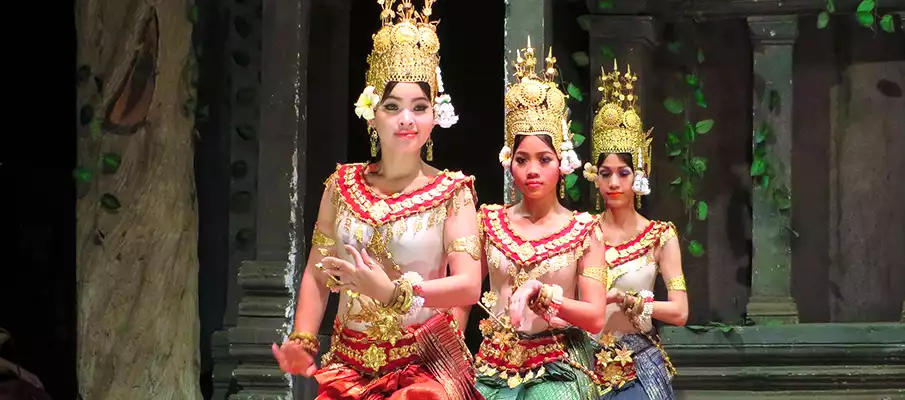
13. The Land of Smiles:
-
- Nestled in the heart of Southeast Asia, Cambodia has earned the affectionate moniker „The Land of Smiles“. Beyond its awe-inspiring temples and scenic landscapes, what truly defines this nation is the warmth and hospitality of its people, whose genuine smiles welcome visitors with open arms.
-
- Cultural Warmth: Cambodia’s culture is deeply rooted in the values of respect, humility, and community. The warmth of the Cambodian people is palpable in everyday interactions, from bustling markets to serene temples. Whether you’re navigating the streets of Phnom Penh or exploring rural villages, the genuine friendliness of the locals leaves a lasting impression.
-
- Hospitality Embedded in Tradition: Hospitality is not just a custom; it’s a way of life in Cambodia. The tradition of welcoming guests with a warm smile and offering hospitality is deeply embedded in Cambodian culture. Visitors often find themselves embraced by the generosity of locals, whether sharing a meal, engaging in conversation, or participating in traditional ceremonies.
-
- Resilient Spirit: Despite a history marked by challenges, including the Khmer Rouge era, the Cambodian people embody a remarkable resilience. The spirit of optimism and the enduring smiles reflect a determination to move forward, rebuild, and share the beauty of their nation with the world.
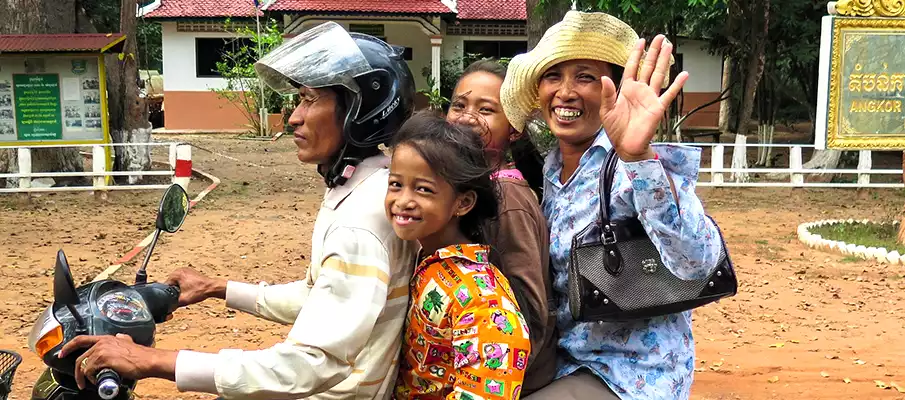
14. Bokator – Ancient Martial Art:
-
- Deep within the cultural tapestry of Cambodia lies a martial art that traces its roots to the Angkorian era – Bokator. This ancient discipline, a fusion of combat, dance, and spirituality, has endured the test of time, surviving centuries to become a symbol of Cambodia’s martial prowess and cultural resilience.
-
- Historical Roots: Dating back over a thousand years, Bokator originated during the Angkorian Empire, a testament to the kingdom’s emphasis on physical and mental discipline. Initially developed for warfare, the art form evolved to incorporate ritualistic aspects, becoming not just a combat technique but a cultural expression.
-
- Spiritual Harmony: Bokator is more than a series of physical movements; it’s a spiritual practice that aligns the body, mind, and soul. Practitioners engage in meditative rituals and adhere to a strict code of ethics, fostering a harmonious balance between strength and inner serenity.
-
- Animal-Inspired Movements: At the core of Bokator’s unique charm are its animal-inspired movements. The martial art mimics the behaviors of creatures like the lion, elephant, and eagle, adding a symbolic layer to the physical techniques. Each stance and strike tells a story, connecting the practitioner with Cambodia’s natural world.
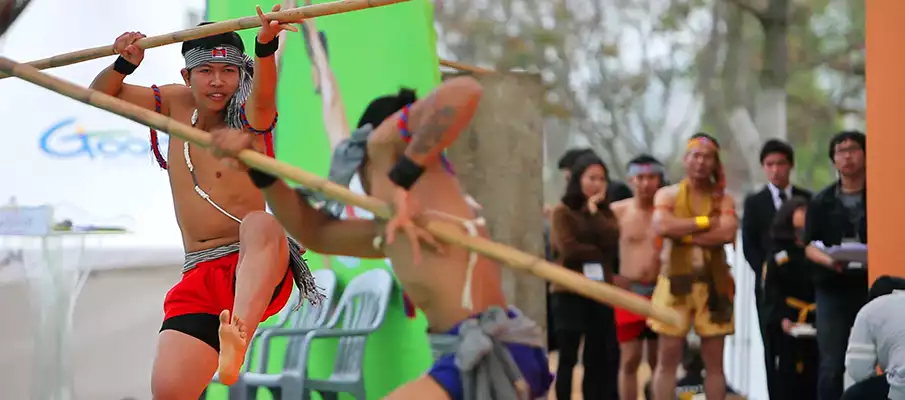
15. The Silver Pagoda’s Emerald Buddha:
-
- Nestled within the confines of Phnom Penh’s Royal Palace, the Silver Pagoda, or Wat Preah Keo Morokat, cradles a rare and radiant treasure—the Emerald Buddha. This sacred and glistening icon is not only a centerpiece of Cambodian spirituality but a testament to the nation’s enduring connection with Buddhism.
-
- Glimmering Splendor: The Silver Pagoda derives its name from the thousands of silver tiles that adorn its floor, creating a shimmering effect when bathed in sunlight. Amidst this splendor, the Emerald Buddha takes center stage, a statue crafted from a single piece of jade with hues that range from rich green to translucent emerald.
-
- Royal Sanctuary: The Silver Pagoda, commissioned by King Norodom in 1892, serves as a symbolic and spiritual sanctuary for Cambodia’s monarchs. It stands as a testament to the enduring influence of Buddhism in the country, where the union of spirituality and royalty is deeply ingrained in the cultural fabric.
-
- Origins of the Emerald Buddha: The Emerald Buddha, though not of Cambodian origin, found its way to the Silver Pagoda in the early 20th century. Crafted in the classic meditative pose, the Buddha’s serene countenance and the vibrant green of the jade symbolize purity, tranquility, and enlightenment in the Buddhist tradition.
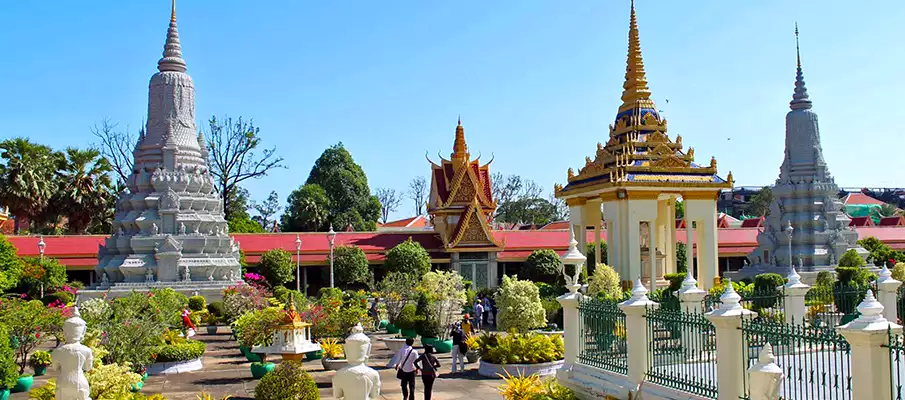
❓ Questions + Tips – Interesting Facts about Cambodia:
1. What are the must-visit historical sites in Cambodia?
-
- Cambodia is home to the iconic Angkor Wat in Siem Reap, a colossal temple complex and the largest religious monument globally. The Angkor Archaeological Park, encompassing structures like Bayon Temple and Ta Prohm, offers a captivating journey through the remnants of the Khmer Empire, showcasing remarkable architectural prowess and cultural significance.
2. What is the significance of Angkor Wat Temple Complex?
-
- Angkor Wat, constructed in the 12th century, stands as a testament to Khmer artistry and spirituality. Initially dedicated to the Hindu god Vishnu, it later transformed into a Buddhist pilgrimage site. The temple’s intricate bas-reliefs and towering spires narrate the tale of the Khmer Empire’s grandeur and cultural evolution.
3. Are there any lesser-known temples worth exploring in Angkor?
-
- Venturing beyond the well-trodden path, Banteay Srei emerges as a hidden jewel. Dubbed the „Citadel of the Women,“ this temple, constructed with exquisite pink sandstone, showcases delicate and intricate carvings, highlighting the unparalleled craftsmanship of the Khmer artisans.
4. What natural wonders does Cambodia offer?
-
- Cambodia boasts the Tonle Sap Lake, the largest freshwater lake in Southeast Asia. What makes it fascinating is the „Great Lake“ phenomenon, where its water flow changes direction with the seasons, impacting the surrounding ecosystems and creating a unique natural spectacle.
5. What is the cultural significance of the Royal Palace in Phnom Penh?
-
- The Royal Palace in Phnom Penh serves as a living testament to Cambodia’s monarchy. Its architectural splendor, blending traditional Khmer design with European influences, houses the Silver Pagoda, adorned with a silver floor, and the Emerald Buddha. The palace is a symbol of Cambodia’s regal heritage.
6. Are there any traditional dance performances in Cambodia?
-
- Apsara dance, a classical Khmer dance, is a captivating cultural experience. Adorned in elaborate costumes, dancers perform graceful movements that narrate stories from Hindu mythology. This traditional dance form provides a visual feast for audiences.
7. What role does the Mekong River play in Cambodia’s culture?
-
- The Mekong River holds profound cultural and economic significance for Cambodia. It sustains fertile soil for agriculture, influences the country’s diverse ecosystems, and connects to the Tonle Sap Lake, which plays a pivotal role in Cambodia’s fisheries and traditional livelihoods.
8. What is the history of the Khmer Rouge regime?
-
- Cambodia’s recent history is marred by the tragic Khmer Rouge regime (1975-1979), led by Pol Pot. The Killing Fields and the Tuol Sleng Genocide Museum in Phnom Penh bear witness to the atrocities committed during this dark period, serving as poignant reminders of Cambodia’s resilience and the importance of remembrance.
9. What are Cambodia’s traditional dishes?
-
- Cambodia’s culinary landscape offers delights such as Fish Amok, a fragrant fish curry steamed in banana leaves, and Lok Lak, a flavorful stir-fried beef dish. Nom Banh Chok, a traditional rice noodle soup often consumed for breakfast, adds to the country’s diverse gastronomy.
10. Can you recommend any off-the-beaten-path destinations in Cambodia?
-
- For a serene island getaway, Koh Rong Samloem beckons with pristine beaches and a laid-back ambiance. Battambang, with its French colonial architecture and the unique bamboo train, offers an authentic Cambodian experience away from the bustling tourist trail.
11. What is the Cambodia’s efforts in preserving its wildlife?
-
- Cambodia is dedicated to wildlife conservation, with initiatives focused on protecting biodiversity. The Cardamom Mountains and Virachey National Park serve as sanctuaries for diverse ecosystems, providing habitats for endangered species like the Indochinese tiger and Asian elephant.
12. What are the traditional Cambodian festivals?
-
- The Water Festival, or Bon Om Touk, is a nationwide celebration featuring vibrant boat races and lively processions, marking the reversal of the Tonle Sap River’s flow. Khmer New Year, or Chaul Chnam Thmey, is a lively cultural celebration characterized by traditional performances, music, and joyful gatherings.
13. Are there any specific etiquette tips for travelers in Cambodia?
-
- Observing local customs is essential in Cambodia. When visiting temples, wearing modest clothing is respectful, and it’s customary to remove shoes before entering someone’s home. Bargaining is common in markets, but maintaining a polite and friendly demeanor is key.
14. How has tourism impacted Cambodia’s economy and culture?
-
- Tourism has played a pivotal role in Cambodia’s economic development, contributing significantly to employment and infrastructure. However, the challenge lies in balancing the economic benefits with the preservation of Cambodia’s cultural and natural heritage. Sustainable tourism practices are crucial to ensuring the long-term integrity of the country’s unique identity.
15. How to explore Cambodia – What are the transport options?
-
- In Cambodia you can travel by bus, minivan, minibus, train by Royal Railway (railway network and schedule is very limited), you can also use domestic flights and islands are accessible by speedboats/ferry. In various destinations you can also rent a bicycle or motorbike (IDP is necessary).
16. What is the weather in Cambodia and what to expect?
-
- In Cambodia, the weather is characterized by a tropical climate with distinct wet and dry seasons. The dry season, from November to April, brings lower humidity and minimal rainfall, making it an ideal time for outdoor activities. Conversely, the wet season, from May to October, sees heavier rainfall and higher humidity. It’s important to be prepared for sudden downpours during this time, and some areas may experience flooding. Checking local forecasts is advisable for more accurate and timely information on the weather in Cambodia.
17. What is the currency of Cambodia and how to exchange money?
-
- Cambodia’s official currency is the Cambodian Riel (KHR), but the US Dollar (USD) is widely accepted and used in various transactions. The exchange rate is approximately around 4,000 KHR for 1 USD. Travelers can exchange money at banks or currency exchange booths, with banks typically providing better rates, albeit having more limited operating hours. While credit cards are accepted in some upscale establishments and restaurants, cash remains the preferred form of payment, especially in more rural regions. Therefore, it’s recommended for visitors to carry both US Dollars and Cambodian Riel, especially when venturing into less touristy areas.
BOOK a TOUR / ACTIVITY in Cambodia ➜
| Interesting Things of Cambodia: | Detailed Descriptions |
|---|---|
| 1. Angkor Wat’s Architectural Marvel: |
Embark on a mesmerizing journey to Angkor Wat, the crown jewel of Cambodia’s architectural marvels. This UNESCO World Heritage site is not merely a temple; it’s a sprawling complex that spans over 400 acres, making it the largest religious monument globally. The intricate carvings depict mythological narratives and historical events, providing a vivid insight into the Khmer Empire’s grandeur. As the sun rises, Angkor Wat unveils its timeless beauty, making it a must-visit destination that narrates Cambodia’s rich past with every stone. |
| 2. Khmer Rouge History in Phnom Penh: |
Dive deep into Cambodia’s poignant history at the Tuol Sleng Genocide Museum and the Killing Fields in Phnom Penh. These somber sites bear witness to the atrocities committed during the Khmer Rouge regime, a dark chapter in Cambodia’s recent past. The museum, housed in a former prison, displays harrowing photographs and artifacts, offering a sobering glimpse into the lives affected. Visiting these historical landmarks provides a profound understanding of Cambodia’s resilience and the profound impact of its journey from tragedy to hope. |
| 3. Tonlé Sap’s Floating Village Life: |
Immerse yourself in the unique way of life at Tonlé Sap, Southeast Asia’s largest freshwater lake. Beyond its sheer size, Tonlé Sap is known for its floating villages, where stilted houses and floating markets define the daily existence of the locals. Explore the symbiotic relationship between the lake and its residents, witnessing the ebb and flow of the waters. The dynamic ecosystem and resilient communities around Tonlé Sap showcase Cambodia’s adaptability and the coexistence of nature and human life. |
| 4. Bayon Temple’s Smiling Faces: |
Step into the enigmatic world of Bayon Temple, nestled within the Angkor Thom complex. What sets Bayon apart are the iconic stone faces that adorn its towers, believed to depict the compassionate gaze of the bodhisattva Avalokiteshvara or perhaps the king who commissioned it. Beyond the captivating smiles, Bayon’s bas-reliefs depict daily life, battles, and religious ceremonies, providing a comprehensive view of Khmer society. Exploring Bayon is a captivating journey into the artistic and spiritual legacy of ancient Cambodia. |
| 5. Breathtaking Banteay Srei: |
Discover the exquisite beauty of Banteay Srei, a temple dedicated to the Hindu god Shiva. What makes Banteay Srei exceptional is its intricate pink sandstone carvings, showcasing a level of detail that is unmatched in other Angkorian temples. Often referred to as the „Citadel of Women,“ this temple’s delicate craftsmanship and smaller scale provide an intimate encounter with Khmer artistry. Banteay Srei stands as a testament to the mastery of the Khmer artisans who left an indelible mark on Cambodia’s architectural heritage. |
| 6. Apsara Dance Tradition: |
Immerse yourself in the timeless elegance of traditional Apsara dance, a classical Khmer art form that transcends generations. Apsara dance, characterized by intricate hand gestures and elaborate costumes, tells stories of Cambodian folklore, mythology, and history. Attend a live performance in Siem Reap or Phnom Penh to witness the dancers‘ skillful storytelling through movement. Apsara dance not only showcases the artistic finesse of Cambodia but also serves as a living link to the country’s cultural heritage, captivating audiences with its grace and sophistication. |
| 7. Prasat Preah Vihear’s Cliff-top Splendor: |
Ascend to the summit of Prasat Preah Vihear, an awe-inspiring temple perched on a clifftop in the Dângrêk Mountains. This UNESCO World Heritage site offers not only a historical journey but also breathtaking panoramic views that extend into neighboring Thailand. The temple’s strategic location and architectural grandeur make it a testament to Cambodia’s historical and cultural ties to the region. Exploring Prasat Preah Vihear is an adventure that combines archaeological fascination with the allure of commanding vistas. |
| 8. Cambodia’s Culinary Tapestry: |
Embark on a sensory adventure through Cambodia’s diverse culinary landscape, where traditional Khmer cuisine intertwines with influences from neighboring countries. Indulge in the rich flavors of Fish Amok, savor the boldness of Lok Lak, and experience the aromatic delights of Khmer Red Curry. Cambodia’s culinary tapestry reflects the country’s cultural diversity and historical influences, offering a delightful exploration of tastes and textures that define the nation’s gastronomic identity. From street markets to local eateries, every meal is a celebration of Cambodia’s rich culinary heritage. |
| 9. Sihanoukville’s Coastal Bliss: |
Find serenity in the coastal bliss of Sihanoukville, a haven boasting pristine beaches, turquoise waters, and a laid-back atmosphere. Whether you’re lounging on the sandy shores of Otres Beach or partaking in water activities at Serendipity Beach, Sihanoukville offers a perfect blend of relaxation and adventure along Cambodia’s stunning coastline. Explore the vibrant beach culture, indulge in delectable seafood, and witness breathtaking sunsets over the Gulf of Thailand as Sihanoukville provides an idyllic coastal escape. |
| 10. Ta Prohm’s Nature Embrace: |
Embark on a mystical journey through the captivating embrace of nature at Ta Prohm. This temple within the Angkor Archaeological Park stands as a unique testament to the symbiotic relationship between ancient structures and the surrounding jungle. As giant fig and silk-cotton trees intertwine with the temple’s stones, Ta Prohm creates an otherworldly atmosphere. Immortalized in films such as „Tomb Raider,“ this enchanting destination offers a poetic reminder of the relentless passage of time and the enduring connection between human history and the natural world. |
Solo Travel in Malaysia|Solo Travel in Vietnam|Solo Travel in Thailand|Vietnam Culture|Floating Marketes in Vietnam|Best Islands in Thailand

